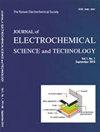温度对锂离子电池长时间循环过程中石墨基负极劣化的影响
IF 3
4区 工程技术
Q3 ELECTROCHEMISTRY
Journal of electrochemical science and technology
Pub Date : 2022-04-14
DOI:10.33961/jecst.2021.00899
引用次数: 1
摘要
在本文中,我们报道了在锂离子电池(LIBs)的长期循环过程中,温度对石墨基负极劣化的影响。在45°C(45细胞)和25°C(25细胞)的温度下循环75Ah袋型LIB全细胞直到其寿命结束后,我们预计会观察到负极根据温度的变化。电池的负电极的厚度在循环之后更大;45细胞的电极(144µm)大于25细胞的电极的电极(109µm)。截面扫描电子显微镜分析证实副产物导致负电极厚度的增加。循环过程中在负极表面上形成的副产物增加了表面电阻并降低了电导率。电压曲线显示,25 Cell的负极显示出84.7%的初始容量保留率,而45 Cell的正极仅显示出70.3%的保留率。这项研究的结果有望与未来负极劣化特性和电池劣化机制的分析相关,也有望为先进的电池设计提供基础数据。本文章由计算机程序翻译,如有差异,请以英文原文为准。
Effect of Temperature on the Deterioration of Graphite-Based Negative Electrodes during the Prolonged Cycling of Li-ion Batteries
In this paper, we report the effects of temperature on the deterioration of graphite-based negative electrodes during the long-term cycling of lithium-ion batteries (LIBs). After cycling 75 Ah pouch-type LIB full cells at temperatures of 45 o C (45-Cell) and 25 o C (25-Cell) until their end of life, we expected to observe changes in the negative electrode according to the temperature. The thickness of the negative electrode of the cell was greater after cycling; that of the electrode of 45-Cell (144 µm) was greater than that of the electrode of 25-Cell (109 µm). Cross-sectional scanning electron microscopy analysis confirmed that by-products caused this increase in the thickness of the negative electrode. The by-products that formed on the surface of the negative electrode during cycling increased the surface resistance and decreased the electrical conductivity. Voltage profiles showed that the negative electrode of 25-Cell exhibited an 84.7% retention of the initial capacity, whereas that of 45-Cell showed only a 70.3% retention. The results of this study are expected to be relevant to future analyses of the deterioration characteristics of the negative electrode and battery deterioration mechanisms, and are also expected to provide basic data for advanced battery design.
求助全文
通过发布文献求助,成功后即可免费获取论文全文。
去求助
来源期刊

Journal of electrochemical science and technology
ELECTROCHEMISTRY-
CiteScore
6.30
自引率
8.10%
发文量
44
期刊介绍:
Covering fields:
- Batteries and Energy Storage
- Biological Electrochemistry
- Corrosion Science and Technology
- Electroanalytical Chemistry and Sensor Technology
- Electrocatalysis
- Electrochemical Capacitors & Supercapcitors
- Electrochemical Engineering
- Electrodeposition and Surface Treatment
- Environmental Science and Technology
- Fuel Cells
- Material Electrochemistry
- Molecular Electrochemistry and Organic Electrochemistry
- Physical Electrochemistry
- Solar Energy Conversion and Photoelectrochemistry
 求助内容:
求助内容: 应助结果提醒方式:
应助结果提醒方式:


